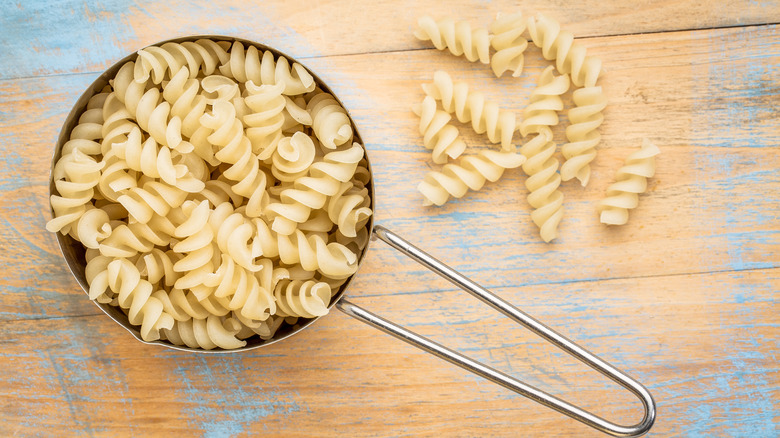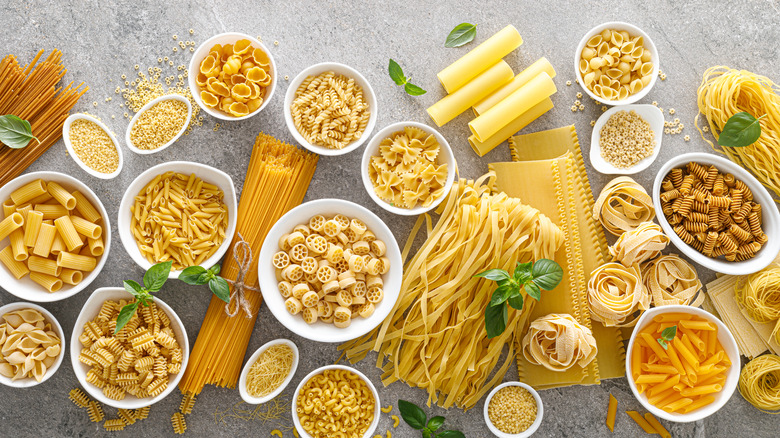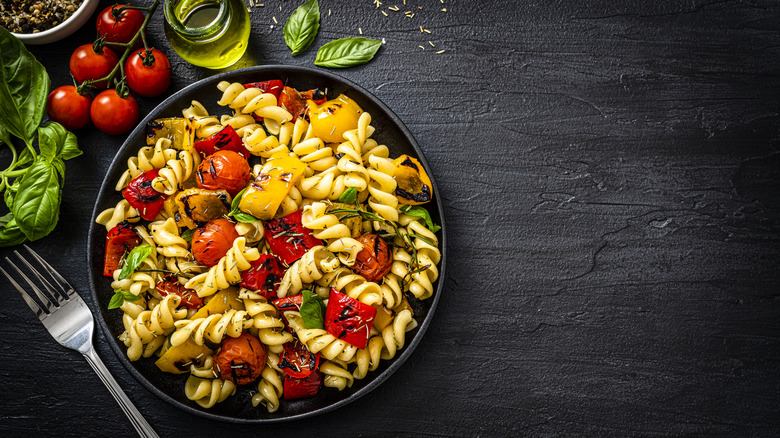Here's How Many Cups Are In A Pound Of Dry Pasta
There are few foods in the world as satisfying as pasta. If you need proof, you can seek out evidence of noodle dishes in just about every culture with flavor profiles and ingredients from basil and parmigiano to cilantro and peanuts.
Beyond its adaptability and global renown, there are plenty of reasons to love pasta, including its affordability and ease of preparation, both of which make it an ideal dish to serve a crowd. That said, it's also a luxury experience to eat a bowl all by yourself. The only issue is that when it comes to preparing dry pasta, it can be tough to decide how much to make. Being that every noodle becomes plumper as it boils, absorbing water through the cooking process, it's hard to eyeball an amount before plunging it into the pot. And because dry pasta itself is tough to accurately measure in cups at all thanks to its rigidity, using a standard volume measurement is pretty much a non-option.
Fortunately, there are some working averages out there: a pound of shaped pasta (think farfalle, fusilli, or ziti) will usually yield about four cups, while strands like spaghetti or fettuccine are closer to two cups. Keeping those starting points in mind will help take the guesswork out of getting your dinner sorted.
More pasta cooking considerations
Those averages are useful when you're not extremely concerned about specificity and having a little less or more is going to be a-okay. If you're looking for a more accurate prediction, however, there are a few more factors to consider. The type of pasta will also affect how the process plumps your finished product. Semolina, a type of hard wheat often used in commercial dry pastas, can come out of the pot twice the size it went in, while options that are designed to be gluten-free or are made with whole wheat won't absorb as much water and will emerge only slightly more swollen than they started. In those cases, you can more easily use the pasta in its dry state to get a sense of how much will be in your bowl.
If you're relying on volume, it's also helpful to memorize or keep on hand in your recipe notebook what is a common yield for your go-to types. For example, ⅔ cup dry penne will turn into about 1¼ cup when cooked, and if you gather up the strands of spaghetti into a bunch that looks about the size of a quarter's diameter, you'll likely get about a cup of cooked pasta. As with most cooking, some trial and error is to be expected.
How to make the most of every cup of pasta
No matter how good you get at measuring out your pasta or memorizing expected yields, you may still end up with an amount that isn't exactly perfect. Never fear. If you wind up with too little pasta, you can find plenty of ways to stretch your noodles into a more substantial meal, and if you have more than you bargained for, leftovers can be transformed into so many exciting options.
If your yield is on the skimpy side, fortify with protein or vegetables, or both like a fennel and sausage pasta. A Tuscan chicken pasta will also help make use of leftover chicken, if you happen to have some on hand, while pasta primavera, bursting with veggies, will help fill your bowl and satisfy your appetite.
Or give your noodles the maritime treatment with a shower of bottarga, or a salted and cured roe that bring a savory brine in spaghetti bottarga di muggine as well as added protein, too.
Leftover pasta works great in a soup like pasta e fagioli, when bathed in a flavorful broth, or add your favorite cheeses, meats, or vegetables for an inspired baked spaghetti. No matter how much you cook up, making pasta will never be a miscalculation.


